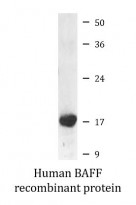ARG70086
Human BAFF recombinant protein (Active) (His-tagged, C-ter)
Human BAFF recombinant protein (Active) (His-tagged, C-ter) for SDS-PAGE
Overview
| Product Description | E. coli expressed, His-tagged (C-ter) Active Human BAFF recombinant protein |
|---|---|
| Tested Application | SDS-PAGE |
| Target Name | BAFF |
| Species | Human |
| A.A. Sequence | Ala134 - Leu285 |
| Expression System | E. coli |
| Activity | Active |
| Activity Note | Determined by its ability to induce IL-8 secretion in human PBMCs. The ED50 for this effect is < 0.5 ng/mL. |
| Alternate Names | BLYS; TALL1; Dendritic cell-derived TNF-like molecule; THANK; DTL; TNF- and APOL-related leukocyte expressed ligand 1; TNFSF20; CD257; BLyS; Tumor necrosis factor ligand superfamily member 13B; ZTNF4; CD antigen CD257; B lymphocyte stimulator; TALL-1; BAFF; B-cell-activating factor |
Properties
| Form | Powder |
|---|---|
| Purification Note | Endotoxin level is less than 0.1 EU/µg of the protein, as determined by the LAL test. |
| Purity | > 98% (by SDS-PAGE) |
| Buffer | PBS (pH 8.0) |
| Reconstitution | It is recommended to reconstitute the lyophilized protein in sterile water to a concentration not less than 200 μg/mL and incubate the stock solution for at least 20 min at room temperature to make sure the protein is dissolved completely. |
| Storage Instruction | For long term, lyophilized protein should be stored at -20°C or -80°C. After reconstitution, aliquot and store at -20°C or -80°C for up to one month. Storage in frost free freezers is not recommended. Avoid repeated freeze/thaw cycles. Suggest spin the vial prior to opening. |
| Note | For laboratory research only, not for drug, diagnostic or other use. |
Bioinformation
| Gene Symbol | TNFSF13B |
|---|---|
| Gene Full Name | tumor necrosis factor (ligand) superfamily, member 13b |
| Background | The protein encoded by this gene is a cytokine that belongs to the tumor necrosis factor (TNF) ligand family. This cytokine is a ligand for receptors TNFRSF13B/TACI, TNFRSF17/BCMA, and TNFRSF13C/BAFFR. This cytokine is expressed in B cell lineage cells, and acts as a potent B cell activator. It has been also shown to play an important role in the proliferation and differentiation of B cells. Alternatively spliced transcript variants encoding distinct isoforms have been identified. [provided by RefSeq, Mar 2011] |
| Function | Cytokine that binds to TNFRSF13B/TACI and TNFRSF17/BCMA. TNFSF13/APRIL binds to the same 2 receptors. Together, they form a 2 ligands -2 receptors pathway involved in the stimulation of B- and T-cell function and the regulation of humoral immunity. A third B-cell specific BAFF-receptor (BAFFR/BR3) promotes the survival of mature B-cells and the B-cell response. Isoform 2 seems to inhibit isoform 1 secretion and bioactivity. Isoform 3: Acts as a transcription factor for its own parent gene, in association with NF-kappa-B p50 subunit, at least in autoimmune and proliferative B-cell diseases. The presence of Delta4BAFF is essential for soluble BAFF release by IFNG/IFN-gamma-stimulated monocytes and for B-cell survival. It can directly or indirectly regulate the differential expression of a large number of genes involved in the innate immune response and the regulation of apoptosis. [UniProt] |
| Cellular Localization | Cell membrane; Single-pass type II membrane protein. Tumor necrosis factor ligand superfamily member 13b, soluble form: Secreted. [UniProt] |
| PTM | The soluble form derives from the membrane form by proteolytic processing. Isoform 2 is not efficiently shed from the membrane unlike isoform 1. N-glycosylated. [UniProt] |
Images (1) Click the Picture to Zoom In






